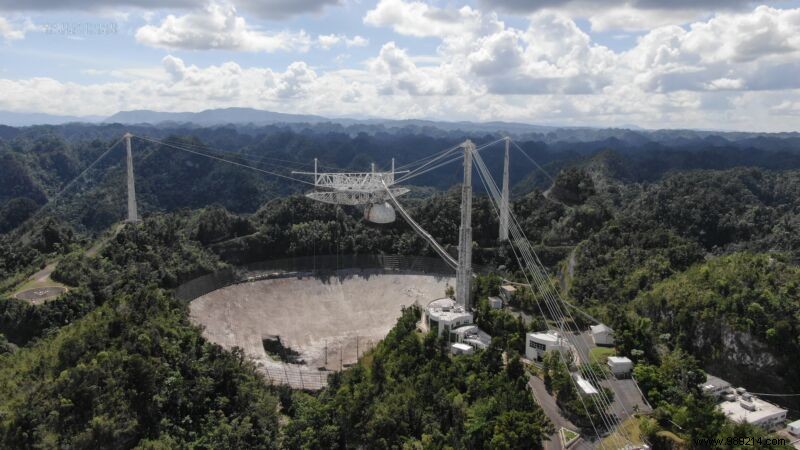Already weakened for several years, two successive accidents that occurred this year finally sealed the fate of the structure. Built on top of a hill in Puerto Rico, the Arecibo radio telescope will soon be dismantled.
Since its commissioning in 1963, the observatory has faced several threats. The passage of Hurricane Maria three years ago had notably forced the engineers to put the telescope offline for several months. More recently, in August, one of the auxiliary cables supporting the 900 ton metal platform , located above the observatory, then broke. Following this break, a piece of this cable then cut the reflector antenna of the telescope for thirty meters .
From then on, the future of the radio telescope began to become uncertain. And for good reason, the observatory had already been in the hot seat for several years, due to lack of funding. While a repair mission was still planned, a new incident unfortunately occurred at the beginning of November. The second cable, attached to the same tower as the first, broke in turn, causing additional damage.
After reviewing three separate technical reports, the National Science Foundation (NSF), which manages the structure, decided that the facility had become too unstable to attempt yet another rescue mission. The radio telescope will eventually be abandoned.
"Our goal was to find a way to preserve the telescope without putting anyone's safety at risk" said Sean Jones, deputy director of the NSF's Mathematical and Physical Sciences Branch. “However, after receiving and reviewing the technical assessments, we have found no way forward that would allow us to do so. And we know that a delay in decision-making puts the entire facility at risk of uncontrolled collapse, unnecessarily endangering people and also additional facilities” .
NSF has since brought in engineers to come up with a controlled decommissioning plan . It is possible that the structure will be dismantled by helicopter, or simply destroyed by explosives. A decision will be made in the coming weeks.
Ralph Gaume, director of the Astronomical Sciences Division of the NSF, for his part assured that the agency will work with the scientists who plan to use the Arecibo telescope and its other facilities to move their research projects where possible.

The Arecibo was until 2016 the largest single-parabola radio telescope in the world (300 meters in diameter). Over the past few decades, it has enabled the tracking of many asteroids close to Earth. It was also he who, in August 1989, made it possible to image one of these objects for the first time in history (asteroid 4769 Castalia). SETI also relies on it to "listen" to the skies for signals of extraterrestrial civilizations .
The observatory's reputation also extends beyond the scientific community alone. Several scenes from the movie Goldeneye (the James Bond of 1995) were notably filmed in its enclosure. You will also find him in the science fiction film Contact (1997), based on the eponymous novel by Carl Sagan published in 1985.